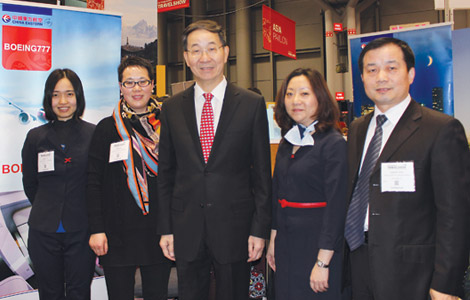China making progress on fighting pollution: experts
Updated: 2014-03-03 12:00
By Zhang Yang in New York (China Daily USA)
|
||||||||
While photos of Chinese people wearing masks in smoggy city streets continue to paint one picture in the headlines, leading China experts in the US are finding signs that China is starting to make some progress in its Herculean fight against pollution.
"A big part the new measures being introduced are directed at controlling China's coal consumption," Ailun Yang, senior associate at World Resources Institute, said in a teleconference call with reporters on Feb 28.
"We've seen coal consumption slowing down for a couple of years, but last year, new coal development really has dropped significantly," said Yang. "People have started to bid farewell to the golden decade of coal growth."
Yang also said that there has been an unprecedented "political openness" to talk about the controlling of coal production and consumption, and that institutions are doing research to advocate coal consumption caps in the next few years.
China's coal consumption took up about 65.7 percent of its total energy use in 2013. The government plans to get the number down to less than 65 percent this year, according to a government plan released in January.
But as total energy demand is still growing, coal consumption will continue to increase as well, though at a slower pace. According to the BP Energy Outlook 2035 released earlier this year, China's demand for coal will not start to decline until 2030.
Acknowledging Beijing's efforts, Yang said it should still be closely monitored how plans are implemented at the local level.
She also highlighted the problem that as many areas in the western part of China are still underdeveloped but rich in coal resources, coal producers are starting to head there. If the government neglects addressing the trend, the problems caused by coal during the industrial development of eastern China may well repeat in the west.
The experts also endorsed China's endeavors to implement carbon-trading markets in seven cities and provinces as an experiment in using market-based methods to tackle emissions problems. The goal is to reduce its carbon emissions per unit of GDP by 40 to 45 percent from its 2005 level by 2020.
The government has ordered the cities of Beijing, Tianjin, Shanghai, Chongqing and Shenzhen, along with the provinces of Hubei and Guangdong, to set caps on emissions and launch a trading scheme. So far five of the markets have been operating a cap-and-trade since last June.
Companies need to pay for any extra carbon emission exceeding the limit assigned by the government, while those who do not deplete the quota can sell their allowance on the market. The mechanism ideally both controls carbon emission and benefits the economy.
"It's fair to say that the seven pilots have really enhanced awareness, beefed up the capacity and strengthened the government's infrastructure regarding carbon policy in China," said Kong Bo, ConocoPhillips Petroleum professor of Chinese and Asian Studies and assistant professor at the University of Oklahoma.
"The carbon market pilots are representing a major commitment and a lot of learning and capacity building has resulted from these pilots," said Chris Nielsen, executive director of the Harvard China Project at Harvard University.
But Nielsen also pointed out that the pilot programs are, after all, in the experimental phase, and if the goal is to ultimately reduce carbon emission, China still has a long way to go.
"There are a lot people in the China expert communities and governments who are not necessarily counting on the success of the trading regime," he said.
Nielsen said that it is difficult to apply carbon trading anywhere in the world. Take the European Union's emission trading system for example, despite its merits, the regime has seen problems such as fraud and drastic price volatility.
"The market almost collapsed in recent years," he said. "Also, they are basically quantifying the success of the ETS (Emissions Trading System) by the scale of financial transactions, but not by CO2 reduction."
Beijing is also considering the imposition of a carbon tax, another major market-based carbon control instrument, said Nielsen.
"Carbon tax is a very economically efficient way to control carbon," said Nielsen, underlining that the case for carbon tax in China is even more compelling than other countries, because it would serve as a comprehensive air pollution control policy.
Regarding the increasing level of PM2.5 - the fine particles with diameter equal or less than 2.5 micrometers that can cause health problems if inhaled -in many parts of China, Nielsen said it is a much bigger challenge than usually perceived.
"These PM2.5 episodes in China are not nearly well understood by scientists let alone by the governments," he said. "It's obviously about emissions but it's also about chemistry and meteorology."
yangzhang@chinadailyusa.com
(China Daily USA 03/03/2014 page2)

 China joins in NY Times' travel show
China joins in NY Times' travel show
 UN envoy condemns terrorism
UN envoy condemns terrorism
 Rio drops protests for Carnival
Rio drops protests for Carnival
 Houston-China bonds deepen with new group
Houston-China bonds deepen with new group
 Citizens mourn victims of Kunming terror attack
Citizens mourn victims of Kunming terror attack
 Putin justifies potential military move in Ukraine
Putin justifies potential military move in Ukraine
 Photos: Kunming rail station violence
Photos: Kunming rail station violence
 Successful businessman gives back to the community
Successful businessman gives back to the community
Most Viewed
Editor's Picks

|

|

|

|

|

|
Today's Top News
US halts military engagements with Russia
Terrorists in Kunming attack busted
First Lady to visit China in March
2014 the year of the Chinese IPO?
China making progress on fighting pollution: experts
Michigan benefits from long-sighted ties building with Chinese
Detroit toasts all time high in China trade
China to severely punish terrorist attackers
US Weekly

|

|






